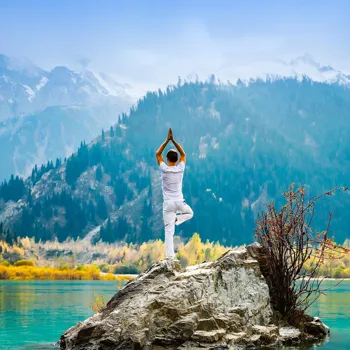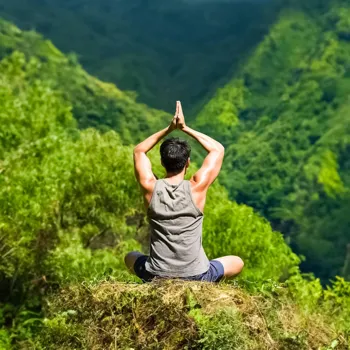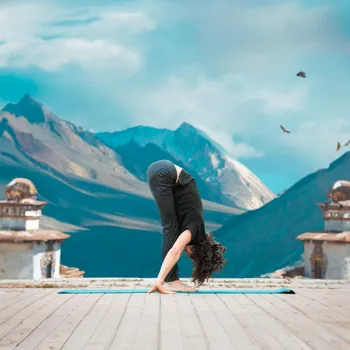Uncover the captivating evolution of Yoga from ancient spiritual roots to a global trend. Dive into its rich history!
Yoga, a discipline deeply rooted in Indian history and philosophy, has traversed a fascinating
journey from being an ancient spiritual practice to a global wellness trend.

Today, you'll find yoga studios sprouting in every corner of the world, from bustling metropolitan cities to quiet countryside retreats. But the yoga that many of us practice today is a far cry from its origins.
To truly appreciate its significance, its benefits, let's take a dive into the captivating history of Yoga, tracing its evolution through the different ages.
Yoga's ancient roots in spiritual practice from Indus Valley
The origins of Yoga are shrouded in the mists of time, going back to the Indus Valley Civilization, around 3000 BCE. Archaeological discoveries, such as seals depicting figures in Yoga postures, hint at the prevalence of yogic practices during this era. These weren't merely physical exercises.

These were part of a sophisticated spiritual system aimed at achieving harmony between mind, body, and spirit. The knowledge was passed down orally from guru to disciple, a tradition which ensured that the teachings were preserved with care.
Development of Vedas in Vedic period laid foundation of Yoga
The Vedic period, spanning from 1500 to 500 BCE, saw the development of the Vedas, a collection of sacred texts that lay the foundation of Hinduism.

While the Vedas don't describe Yoga in its present form, they contain references to concepts like self discipline, breath control (Pranayama), concentration, which are the building blocks of yogic practices.
The Upanishads, philosophical texts that forms the conclusion part of Vedas, delved deeper into these concepts, emphasizing the importance of self realization and liberation from the cycle of birth and death.
Yoga's evolution by Patanjali: Eight Limbs for self-realization
The path of Yoga truly began to take shape during the classical period, most notably by the revered sage Patanjali. In his Yoga Sutras, a compilation of 196 aphorisms (short, concise statements), Patanjali provided a systematic framework for Yoga practice.

This framework, known as Ashtanga Yoga, or the Eight Limbs of Yoga, outlines a comprehensive path towards self realization.
These eight limbs include ethical conduct (Yamas), self discipline (Niyamas), physical postures (Asanas), breath control (Pranayama), withdrawal of the senses (Pratyahara), concentration (Dharana), meditation (Dhyana), and finally, Samadhi (liberation).
Patanjali's Yoga Sutras remain a cornerstone and a guide for serious yoga practitioners.
Medieval period saw development of Hatha Yoga and rise of Tantra
The medieval period (500-1500 CE) witnessed further development of Yoga, with various schools and traditions emerging. Hatha Yoga came into prominence, emphasizing physical postures (Asanas) and breath control (Pranayama) as a means to purify the body and prepare it for higher spiritual practices.
The Hatha Yoga Pradipika, a classical text written in the 15th century, provides detailed instructions on various Hatha Yoga techniques. This period saw a shift in focus towards the physical aspects of Yoga, making it more accessible to a wider audience.
The rise of Tantra also influenced Yoga during this time, incorporating rituals and practices aimed at harnessing energy and expanding consciousness.
Modern Yoga's evolution linked to key figures Swami Vivekananda, Krishnamacharya; journey to West
Modern Yoga, as we know it today, began to take shape in the late 19th and early 20th centuries. Swami Vivekananda, a charismatic Indian monk, played a pivotal role in introducing Yoga to the West.
His lectures and demonstrations at the World's Parliament of Religions in Chicago in 1893 sparked immense interest in Indian philosophy and Yoga. Later, other Yoga masters, such as Paramahansa Yogananda, T. Krishnamacharya, and his disciples B.K.S.
Iyengar and Pattabhi Jois, further popularized Yoga in the West. Krishnamacharya is widely regarded as the "father of modern Yoga," who developed various styles like Vinyasa.
Yoga: From spiritual practice to global exercise trend
Today, Yoga has become a global phenomenon, practiced by millions across the world. It is no longer just a spiritual practice. It has also evolved into a form of exercise, stress management technique, and a way to improve overall well being.

Various styles of Yoga have emerged, catering to different needs and preferences, from the dynamic Vinyasa to the gentle restorative Yoga.
While the focus of Yoga in the West may sometimes be more on the physical aspects, the essence of Yoga still lies in its ability to promote harmony between mind, body, and soul.
As we continue to embrace Yoga in its various forms, let's also remember to honor its rich history and the profound wisdom it offers.
AI Generated Content. Glance/InMobi shall have no liability for the content












